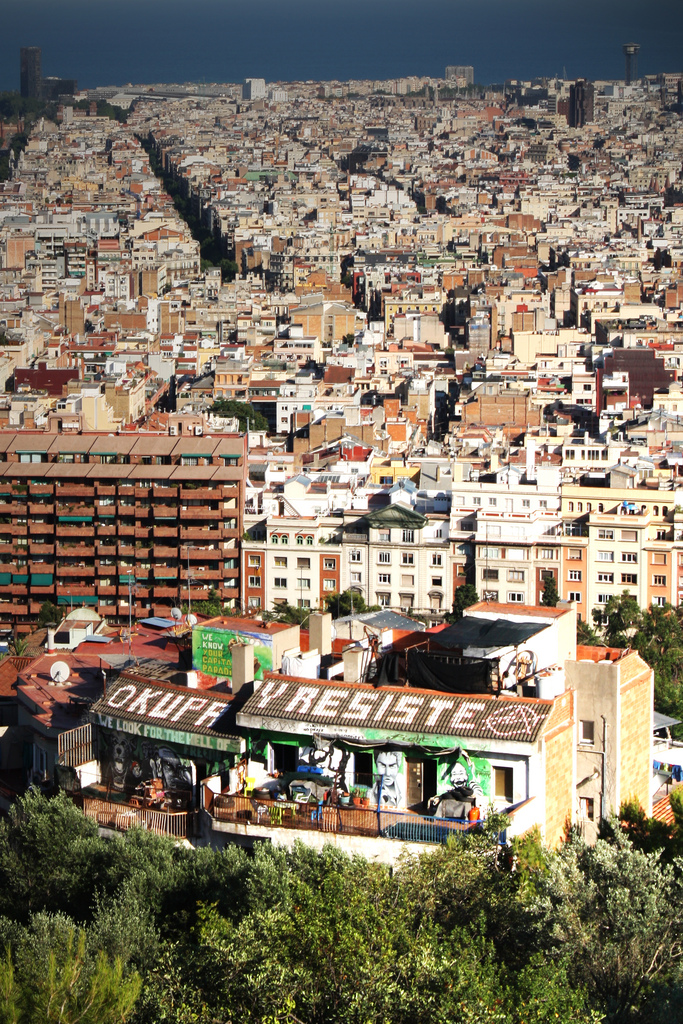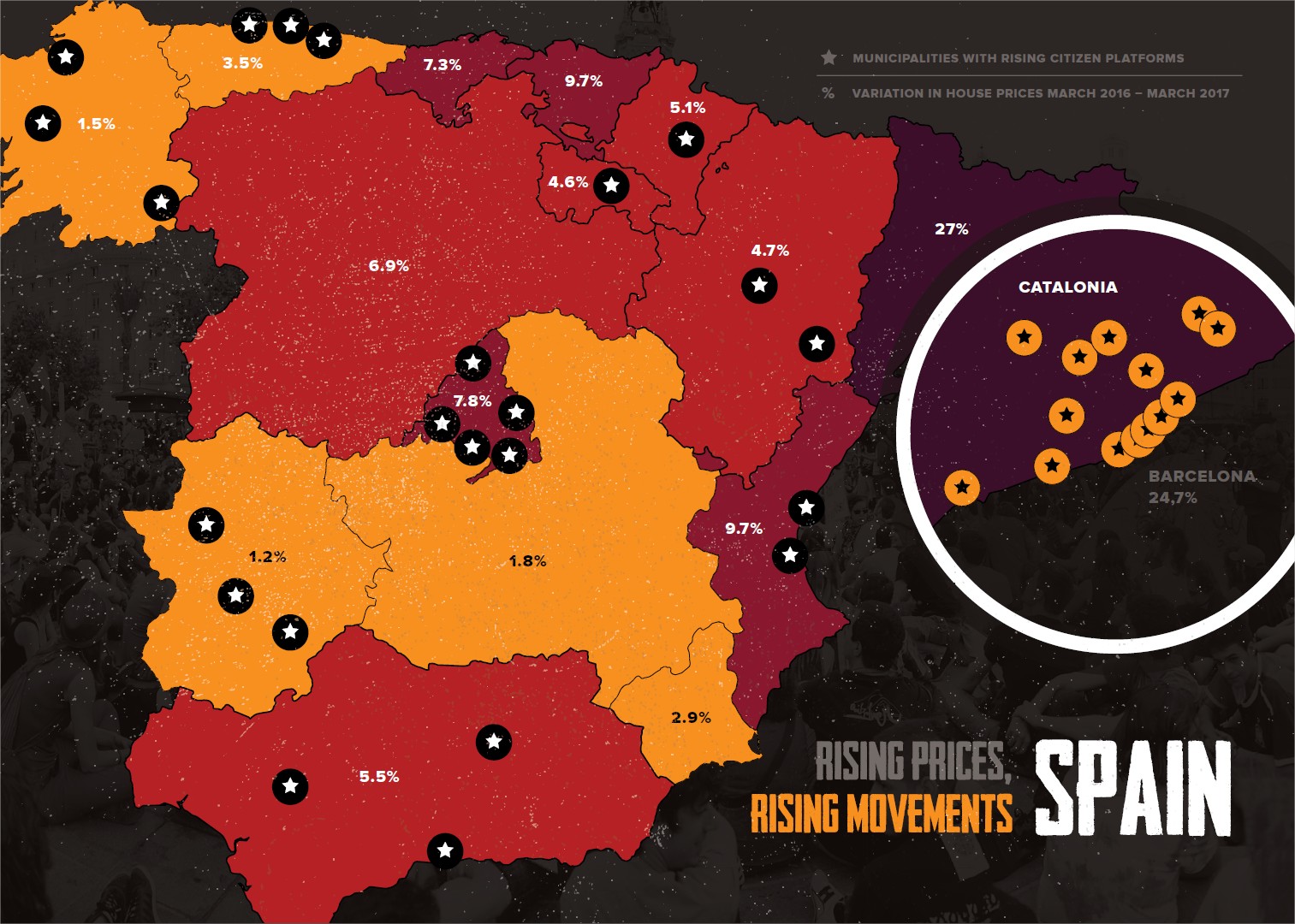Spanish Municipalism
Two years into its governing mandate, how is Spain’s municipalist movement fighting back against the impositions of global capital?
Cities Against the Wall
- Issue #
- Author
By now, the story is well-known in left-wing circles. Two years ago, a handful of civic platforms won municipal elections in most of Spain’s major cities, including Madrid, Barcelona, Zaragoza, Cádiz and Santiago, among others. Spearheaded by prominent figures from the local social movements, they joined Podemos and various left-wing parties in campaigns that promised nothing short of a democratic revolution. In the aftermath of a brutal economic crash and an outbreak of corruption scandals, they would respond to the profound crisis of legitimacy affecting the Spanish state with a program of radical municipalism, channeling the bottom-up politics of the indignados movement that won hearts and minds in 2011.
Having reached the halfway point of their first mandate, it seems like a good time to ask whether and how the jump from the streets to the institutions has helped advance the demands of the social movements from which these candidacies derived their legitimacy. Have the possibilities for emancipatory systemic change grown and multiplied in this time? Or has neoliberal institutionality converted and absorbed an entire generation of its opponents into its structure? These are complex questions. To begin to answer them, we might first consider the scale of the challenges facing these cities in the current stage of global capitalism. We’ll focus first on the signature issue on which many of the activists who became politicians built their legitimacy: the right to decent housing.
The Great Wall of Money
Walking around Sants or similar working-class neighborhoods in Barcelona, you’re likely to see several flyers offering to buy apartments. Some are handwritten, others are printed out in Arial or Comic Sans fonts. They contain little information besides a first name and a phone number. Some are simply anonymous. But though their appearances may vary, they tend to lead to the same phone numbers.
 An investigative report by the autonomous weekly La Directa revealed that these flyers can be traced back to a handful of companies that have been buying up entire residential blocks, often with renters still living in them. They then persuade tenants to leave their homes, renovate the building and either sell it or rent the flats out at higher prices. How the companies persuade tenants to leave varies. They might offer cash, drastically raise rent or simply refuse to renew a rental contract. When tenants resist, they hire companies like Desokupa (“Unsquat”) to forcefully remove them, providing gainful employment to beefy fascists and often breaking the law in the process.
An investigative report by the autonomous weekly La Directa revealed that these flyers can be traced back to a handful of companies that have been buying up entire residential blocks, often with renters still living in them. They then persuade tenants to leave their homes, renovate the building and either sell it or rent the flats out at higher prices. How the companies persuade tenants to leave varies. They might offer cash, drastically raise rent or simply refuse to renew a rental contract. When tenants resist, they hire companies like Desokupa (“Unsquat”) to forcefully remove them, providing gainful employment to beefy fascists and often breaking the law in the process.
This practice tends to be depicted in the media as a local problem in which a handful of unscrupulous businesses exploit loopholes and legal grey areas to turn a profit. But it goes far beyond Barcelona. Companies like these are the shock troops of a massive rent bubble that is affecting all of Spain’s major cities. According to leading Spanish property website Idealista, rental prices increased across the country by 15.9 percent in 2016 alone, with year-over-year growth rates approaching 20 percent during the first trimester of 2017 in places like Barcelona, San Sebastian and the Canary and Balearic Islands. At the neighborhood level, the numbers are simply staggering. In places like the Sant Martí and Sant Andreu districts of Barcelona, rental prices have increased by over 30 percent relative to the same time last year.
Few can deal with such sharp increases. As a result, longtime residents are being displaced from their neighborhoods by what real estate services firm Cushman & Wakefield has dubbed “The Great Wall of Money,” a massive pot of capital for global real estate investment worth about $435 billion. As former UN Special Rapporteur on adequate housing Raquel Rolnik describes it, the Great Wall of Money is a floating cloud of finance capital seeking to materialize in a way that evokes colonization. “I deliberately use the term ‘colonization’ because it involves territorial occupation and cultural domination,” she explains in a recent lecture at the Center for Contemporary Culture of Barcelona. “This colonization has just one objective: to extract rent by opening up new frontiers that are capable of generating interest for finance capital.”
While the use of colonization as a metaphor is problematic for its erasure of slavery and genocidal violence, what is certain is that governments thirsting for foreign investment are competing to land this capital in their countries despite its distinct lack of interest in the lives of residents. In Spain’s case, the country recently attracted the Wall of Money by becoming an emerging market for real estate investment trusts, or REITs. These are companies owning income-generating real estate that can be either residential or commercial. The vast majority of that income must be derived from rent and paid out to shareholders as dividends.
REITs were introduced as a legal form in Spain in 2009 under a Socialist Party government. Initially, they were unsuccessful due to a corporate tax rate of 19 percent. But in 2012, Mariano Rajoy’s right-wing government exempted REITs from this tax. It was after this reform took effect that rental prices took off across the country. Alongside developments like the rise of rent-extracting platforms such as Airbnb — which blur the line between residential and commercial properties or formal and informal economies — the central government’s measure breathed new life into the very sector that provoked Spain’s economic crisis in the first place. The work of managing its most dire effects was left to the municipal governments.
Cornered by the State and the Market
Recently, Barcelona En Comú councilwoman Gala Pin went on the agenda-setting Catalan morning show Els matins and confronted the co-founder of MK Premium, the most prominent of the property vultures identified by La Directa’s investigative report. In a heated exchange, she characterized MK Premium’s work as violencia inmobiliaria, or “property violence.” Her choice of words matched the discourse of the housing platform she helped lead before becoming a representative, the Plataforma de Afectados por la Hipoteca, or Mortgage Victims Platform (PAH). As a result of her choice of words, she was accused of demagoguery by the right-wing opposition and sued by MK Premium for slander.
Pin’s nods to the housing movement go beyond mere rhetoric. She often uses her large following on social media to make evictions visible and boost efforts to stop them. “Tomorrow we have five evictions,” reads a typical post. “Despite our efforts, we need collaboration to stop one. Arc del Teatre Street, 9:30am.”
These posts have been criticized in some radical-left circles as either being propagandistic or preemptively deflecting blame for the evictions that do take place under Barcelona En Comú’s watch. Others argue that Pin and other council members using this approach are simply being transparent about the limits of institutional power and calling on people to overcome them when this is unjust. What is clear is that the approach is effective. The resulting mobilizations have stopped numerous evictions, and even more have been stopped by the network of housing offices that the city government revamped to mediate between tenants and landlords.

“Occupy and Resist.” A squat in Barcelona. Photo by Oriol Salvador.
This is just one example of how tension between social movements, local representatives and public administration can be used to strengthen resistance against the impositions of higher-level institutions and economic forces. And Barcelona is not the only city where the municipal government has become more porous to pressure from below. Manuela Carmena’s Ahora Madrid, for instance, have opened the city’s participation system up to citizen-initiated proposals and, like other cities, allocated a portion of the city coffers to participatory budgeting. In Valencia, where progressive green coalition Compromís governs with the support of Valencia En Comú and the Spanish Socialist Party, the city is undertaking a massive shift towards a pedestrian and bike-centered model of sustainable urban mobility. And in Zaragoza, grid electricity is now 100 percent renewable and energy spending has been reduced by nearly 15 percent.
All of these cities have disproven the European Union’s “no alternative” dogma about austerity by increasing social spending and expanding the public housing stock while maintaining balanced budgets and, in some cases, even reducing deficits. They are also pressuring the central government to take in more refugees, and some are defying Rajoy’s racist 2012 healthcare reform by providing universal healthcare regardless of one’s documentation status. In Madrid, Barcelona and Valencia, city governments have repeatedly expressed their desire to close immigrant detention centers, citing human rights violations and taking symbolic and legal actions against them as a result.
These are by no means revolutionary measures. Taken together, they amount to a straightforward social-democratic program combined with green urbanism and participatory governance. But in Europe’s current political climate, polarized as it is by neoliberal technocracy and the ultra-nationalist far right, this is nothing to sneeze at. What makes their defense of the most basic social advances of the last several decades all the more noteworthy is that it has been carried out by minority governments in a highly fragmented political system.
But this success is fragile against the power of the state and the whims of the market. To impose austerity on cities with left-wing governments, the central government merely has to enforce the legislation it passed in 2013 to dramatically reduce municipal autonomy. Treasury Minister Cristobal Montoro has already made his intent to do so abundantly clear. Meanwhile, the rent bubble continues to expand, pushing residents out of their homes and further from the urban center. Cornered by these looming threats, cities cannot afford to limit their efforts to holding the fort — they must also push back.
A Dynamic of Conflict and Complicity
In early June 2017, several neighborhood marches converged at the Plaça Universitat in the center of Barcelona. From there, a crowd of three thousand people ambled through Sant Antoni, Poble Sec and the Raval, three of the areas targeted by the Great Wall of Money. At several points, they stopped in front of specific housing blocks where tenants were resisting the efforts of speculators to kick them out. When they reached the end of their route, protesters cracked open a block of ten flats that had been abandoned for eight years and squatted it.
The march was the latest action in a growing cycle of struggles against the new property bubble. Organized by a platform called Barcelona No Està en Venda (“Barcelona Is Not For Sale”), it brought together several neighborhood assemblies that have sprung up in the last two years to fight displacement by illegal tourist flats and rising rent. It also included the Sindicat de Llogaters, a local Renters’ Union that took shape in early 2017, as well as the anarcho-syndicalist CGT union, the Barcelona Federation of Neighborhood Associations, the Neighborhood Assemblies for Sustainable Tourism and the PAH.
Actions like these set the agenda of public debate, forcing governments and political parties to demonstrate their priorities. In this particular case, it wrested the microphone away from the establishment press, which had hoped to frame recent conflicts between the City of Barcelona, Airbnb and the tourism lobby as one of “touristophobia,” to borrow the term introduced by El País. Instead of complying with an anti-tourist framework — which has racist, classist and xenophobic undertones — the social movements have centered conflict on the property bubble and gentrification. For the most part, Barcelona En Comú have adopted this framing, albeit in confrontation with some sectors of the movement regarding how to target speculators.
This dynamic of conflict and complicity between movements and left-wing parties is particularly visible in Barcelona because the city’s long history of bottom-up organizing has produced a thick social fabric. During the institutional turn that gave way to Barcelona En Comú, the biggest risk was that the transfer of notable activists from the streets to the institutions would produce something like a “brain drain,” gutting and weakening the social movements. But a look at the social conflicts that have taken place since that turn reveals a somewhat different scenario.
Barcelona En Comú has been relatively effective in translating the demands of the social movements that its individual members came from into public policy proposals. They have been less effective in dealing with the demands of movements they had little experience with previously, such as the city’s street vendors and public transport workers. As a result, these movements have emerged as protagonists in the city’s current structure of social antagonism. How the tensions they produce are resolved remains to be seen.
In Madrid, however, there is far less complicity between the social movements and the municipal platform, and far more confrontation. Though its system of primaries was more open than Barcelona En Comú’s, the confluence of organizations that gave way to Ahora Madrid is much more fractured. Moreover, their consensus candidate, current mayor and former judge Manuela Carmena, comes from a much more institutional background than those leading municipalist platforms in other cities.
The difference shows. Carmena has bucked the party’s program on several occasions, using the cult of personality around her and Spain’s “presidentialist” model of municipal governance to isolate herself from criticism by the more radical organizations integrated into Ahora Madrid, such as Ganemos and the Anticapitalistas wing of Podemos. The most disturbing symptom of this divide is the fact that El Patio Maravillas, the squat where Ahora Madrid was conceived, is set to become a block of tourist flats. Here, the gap between the movement and the institution broke ground for the Wall of Money.
Municipalism with a Purpose
For Spain’s municipalist platforms, the problem is that municipalism on its own is not an ideology. It is a form of governance. It can just as well be capitalist or communist, totalitarian or libertarian, nationalist or internationalist. Left open, it is just a brand to fill with capital or an excuse to transfer blame to other instantiations of administrative power. Moreover, an overly simplistic understanding of municipalism risks steamrolling over the conflicts between differing types of municipalities and the power imbalances produced by decades of urbanization and globalization. This is particularly relevant when we consider the profound cultural and political cleavage that has emerged in the Global North as a result of urban extractivism, which pits progressive growing cities against nativist depopulating villages.
To break with the narrow limits and toxic relationships of the neoliberal status quo and avoid becoming a mere vehicle for the reproduction of administrative and territorial self-interest, an emancipatory municipalism requires a horizon to walk towards. This is precisely what social movements provide. In every injustice that they denounce lies a way the world should be and a set of values and practices suppressed by the current social order. From a leftist perspective, these are none other than mutual aid and solidarity.
Materializing values as practices is a cultural and ideological task more than it is a technical one. The logic of governance, in contrast, is mostly technical. As such, it is centered on control and predictability. To avoid being subsumed by that logic of control and predictability, it is not enough for the new representatives to take on the demands of the movements that put them in power. They must instead nurture all of the movements growing in the cracks of the institutional architecture they’ve inherited, as it is precisely these cracks that the Wall of Money seeks to fill with concrete.
The beauty of the Spanish municipal platforms’ electoral victories two years ago was that their very existence was not predicted by the technical logic of governance. This is why municipal gatekeepers view them as a democratic error. What they have now is an opportunity to dismantle that architecture and open it up to the people, movements and memories that have been repressed, erased, exploited or ignored until now. Going forward, their challenge will be to create more uncertainty for speculators and less for those who hope to inhabit the city.
Source URL — https://roarmag.org/magazine/cities-against-the-wall/


